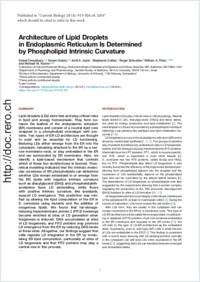Architecture of lipid droplets in endoplasmic reticulum is determined by phospholipid intrinsic curvature
- Choudhary, Vineet Laboratory of Cell and Molecular Biology, National Institute of Diabetes and Digestive and Kidney Diseases, NIH, Bethesda,USA
- Golani, Gonen Department of Physiology and Pharmacology, Sackler Faculty of Medicine, Tel Aviv University, 69978 Tel Aviv, Israel
- Joshi, Amit S. Laboratory of Cell and Molecular Biology, National Institute of Diabetes and Digestive and Kidney Diseases, NIH, Bethesda,USA
- Cottier, Stéphanie Division of Biochemistry, Department of Biology, University of Fribourg, Switzerland
- Schneiter, Roger Division of Biochemistry, Department of Biology, University of Fribourg, Switzerland
- Prinz, William A. Laboratory of Cell and Molecular Biology, National Institute of Diabetes and Digestive and Kidney Diseases, NIH, Bethesda,USA
- Kozlov, Michael M. Department of Physiology and Pharmacology, Sackler Faculty of Medicine, Tel Aviv University, 69978 Tel Aviv, Israel
-
19.03.2018
Published in:
- Current Biology. - 2018, vol. 28, no. 6, p. 915-926.e9
English
Lipid droplets (LDs) store fats and play critical roles in lipid and energy homeostasis. They form between the leaflets of the endoplasmic reticulum (ER) membrane and consist of a neutral lipid core wrapped in a phospholipid monolayer with proteins. Two types of ER-LD architecture are thought to exist and be essential for LD functioning. Maturing LDs either emerge from the ER into the cytoplasm, remaining attached to the ER by a narrow membrane neck, or stay embedded in the ER and are surrounded by ER membrane. Here, we identify a lipid-based mechanism that controls which of these two architectures is favored. Theoretical modeling indicated that the intrinsic molecular curvatures of ER phospholipids can determine whether LDs remain embedded in or emerge from the ER; lipids with negative intrinsic curvature such as diacylglycerol (DAG) and phosphatidylethanolamine favor LD embedding, while those with positive intrinsic curvature, like lysolipids, support LD emergence. This prediction was verified by altering the lipid composition of the ER in S. cerevisiae using mutants and the addition of exogenous lipids. We found that fat-storage-inducing transmembrane protein 2 (FIT2) homologs become enriched at sites of LD generation when biogenesis is induced. DAG accumulates at sites of LD biogenesis, and FIT2 proteins may promote LD emergence from the ER by reducing DAG levels at these sites. Altogether, our findings suggest that cells regulate LD integration in the ER by modulating ER lipid composition, particularly at sites of LD biogenesis and that FIT2 proteins may play a central role in this process.
- Faculty
- Faculté des sciences et de médecine
- Department
- Département de Biologie
- Language
-
- English
- Classification
- Biological sciences
- License
-
License undefined
- Identifiers
-
- RERO DOC 308970
- DOI 10.1016/j.cub.2018.02.020
- Persistent URL
- https://folia.unifr.ch/unifr/documents/306499
Other files
Statistics
Document views: 110
File downloads:
- pdf: 301
- Supplementary material: 162

